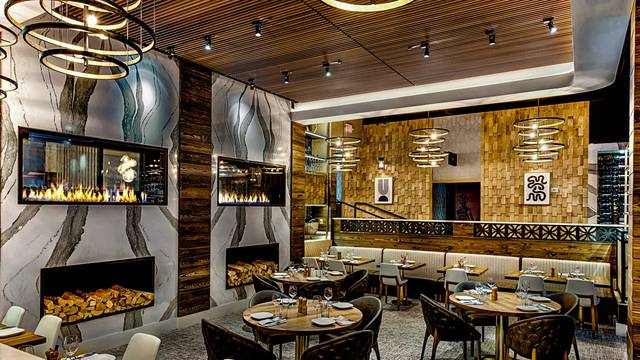Asian Restaurant ISB: A Must-Try Spot for Food Lovers in Islamabad
Asian Restaurant ISB: A Must-Try Spot for Food Lovers in Islamabad
Blog Article
Savor Authentic Oriental Food With a Pan-Asian Twist for a Culinary Journey
Starting a cooking trip with genuine Asian cuisine, improved with a Pan-Asian twist, uses an one-of-a-kind chance to discover the abundant tapestry of flavors that define the region's diverse cooking traditions. This experience invites you to relish the beautiful equilibrium of preferences-- wonderful, salted, spicy, and sour-- integrated by fragrant herbs and seasonings. Picture the ingenious blend of Thai curry and ramen or the unexpected delight of sushi burritos. As you consider these tempting dishes, consider the cultural stories and historical influences that shape them, each bite providing a story waiting to be uncovered.

Exploring Pan-Asian Tastes
In the world of worldwide gastronomy, Pan-Asian cuisine stands apart for its impressive variety and the unified interplay of tastes from different Asian cultures. This cooking technique celebrates the abundant customs and special active ingredients discovered throughout the continent, developing a tapestry of tastes that is both satisfying and intriguing. Key to Pan-Asian food is its capability to stabilize contrasting flavors-- pleasant, salty, spicy, and sour-- while highlighting the quality and high quality of each ingredient.
From the umami-rich soy sauce of Japan to the fiery chili peppers of Thailand, Pan-Asian food offers a considerable scheme of flavors. These elements are usually incorporated in inventive ways, boosting meals with layers of intricacy. As an example, the use of great smelling herbs such as lemongrass and cilantro, typical in Vietnamese and Thai cuisine, adds a refreshing illumination to meals, while the incorporation of coconut milk supplies a velvety, rich appearance.
The focus on fresh fruit and vegetables and fragrant flavors ensures that each meal is not only a banquet for the taste but additionally for the senses. Pan-Asian food invites diners to embark on a cooking trip, discovering the vast and differed landscapes of Oriental gastronomy with every bite.
Blend Meals to Attempt
While Pan-Asian food is commemorated for its traditional tastes, the contemporary culinary landscape is significantly accepting blend recipes that blend these traditional elements with impacts from various other regions. This cutting-edge method not just honors the abundant heritage of Oriental cookeries but additionally presents novel taste experiences that attract contemporary tastes buds.
An archetype of such a combination recipe is the Korean-Mexican taco, where seasoned bulgogi beef is wrapped in a warm tortilla, topped with kimchi and a zesty gochujang-infused salsa. This mix marries the bold, mouthwatering flavors of Korea with the vivid, fresh components of Mexican cuisine. Similarly, sushi burritos have gained popularity, joining together the delicate virtuosity of Japanese sushi with the passionate, hand-held convenience of a burrito, frequently featuring combination components like tempura shrimp and avocado with a drizzle of wasabi mayo.
Another notable recipe is Thai curry ramen, which instills the creamy, aromatic flavors of Thai curry into the soothing broth of typical Japanese ramen, producing an unified blend that entices the detects. These fusion recipes expand beyond mere novelty; they stand for a cooking dialogue in between societies, urging expedition and innovation on the planet of Pan-Asian food.
Vital Ingredients and Spices
To really value Pan-Asian food, one need to understand the important active ingredients and flavors that develop its structure. This varied cooking design draws from an abundant tapestry of Oriental practices, using an unified mix of textures and flavors. Secret ingredients consist of soy sauce, fish sauce, and oyster sauce, which breakfast places give a tasty umami depth necessary to Eastern meals. Corresponding to these are rice vinegar and mirin, lending a delicate level of acidity and sweet taste.
Fragrant aspects are essential, with ginger, lemongrass, and garlic being common across numerous Pan-Asian dishes. These components supply a fragrant base that improves the complexity of tastes. Flavors such as star anise, cardamom, and cinnamon present heat and character, resembling impacts from areas like China and India.

Food Preparation Techniques and Tips
Grasping the art of Pan-Asian cuisine calls for knowledge with its distinctive food preparation methods, each adding to the vivid tapestry of flavors this culinary tradition is commemorated for. Central to these techniques is the stir-fry, a rapid cooking method that maintains the nutritional stability and vivid colors of active ingredients. Utilizing a wok, the stir-fry method enables also heat circulation, important for achieving the particular structure and flavor balance of Pan-Asian dishes.
Another fundamental strategy is steaming, particularly common in Chinese food. This gentle technique preserves the natural flavors and nutrients of components, making it optimal for seafood and veggies. Dumplings, a precious staple, commonly gain from steaming, leading to soft, delicious appearances.
Grilling, likewise important, presents great smoky midsts to recipes such as Oriental bulgogi or Japanese yakitori (asian restaurant isb). This strategy often involves seasoning active ingredients, permitting flavors to permeate deeply before food preparation over an open fire or warmer
Last but not least, understanding the art of balancing flavors-- pleasant, sour, salty, bitter, and umami-- is important. Effectively layering these aspects can elevate a recipe from ordinary to extraordinary, offering a facility and pleasing culinary experience that symbolizes the essence of Pan-Asian food.
Eating Experiences Worldwide
Around the world, Pan-Asian food provides an unmatched eating experience, commemorated for its rich tapestry of tastes and dynamic presentations. This cooking sensation has gone beyond cultural borders, catching the hearts and tastes buds of food enthusiasts worldwide. In worldwide cities hop over to here like New York, London, and Sydney, Pan-Asian restaurants act as melting pots where cooking customs from Thailand, Japan, China, and past assemble, providing diners with a diverse mix of recipes that highlight the region's variety.
The international charm of Pan-Asian food exists in its ability to provide both credibility and advancement. Cooks masterfully wed traditional active ingredients such as lemongrass, soy sauce, and miso with contemporary techniques, leading to meals that are both acquainted and refreshingly new. This combination enables restaurants to start a culinary journey that respects heritage while embracing modernity.
Additionally, eating experiences are elevated through thoughtfully designed atmospheres that mirror the principles of Pan-Asian aesthetic appeals. From minimalist Japanese-inspired interiors to vivid Thai-themed spaces, each restaurant offers an unique ambiance that complements the culinary offerings. As a result, patrons are not just eating a dish but partaking in a social experience, making Pan-Asian eating a genuinely worldwide sensation.
Verdict
The expedition of Pan-Asian cuisine provides a profound understanding of the complex interplay of flavors and cooking practices throughout Asia. By accepting fusion dishes such as Thai curry ramen and sushi burritos, the cooking trip not just highlights the adaptability of traditional active ingredients however also showcases cutting-edge contemporary techniques. This gastronomic journey, enhanced by crucial spices and cooking approaches, gives an unique possibility to appreciate the multiculturalism and culinary artistry that specify Pan-Asian food on an international range.
Beginning on a cooking journey through authentic Asian food, enhanced with a Pan-Asian spin, supplies an one-of-a-kind possibility to explore the abundant tapestry of tastes that specify the region's varied cooking customs.In the realm of global gastronomy, Pan-Asian food stands out for its remarkable variety and the harmonious interaction of flavors from numerous Asian societies. Key to Pan-Asian food is its capability to stabilize contrasting tastes-- pleasant, salty, read what he said spicy, and sour-- while highlighting the freshness and high quality of each ingredient.

Report this page